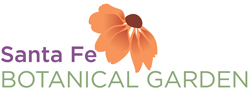| Scientific name: | Common names: |
| Viola canadensis | Canadian white violet, Canada violet, tall white violet |
| Viola adunca | dog violet, hooked spur violet, early blue violet, sand violet, western dog violet |
| Viola orbiculata | darkwoods violet, roundleaf violet |
| Viola tricolor var. hortensis | pansy, heartsease |
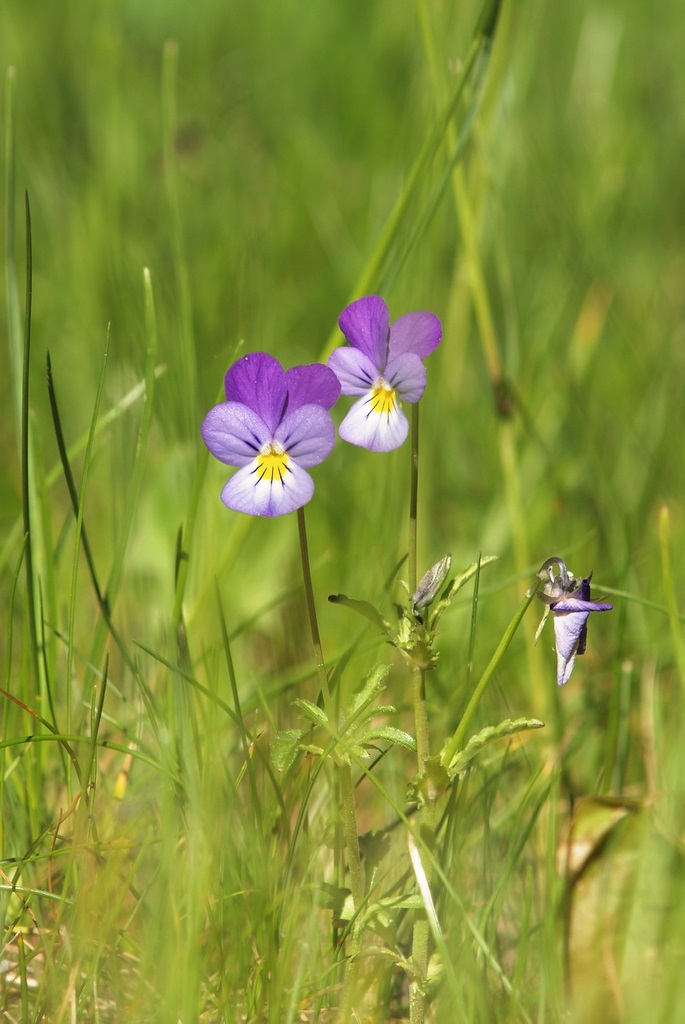
Viola tricolor. Jörg Hempel. CC-BY-SA 2.0
Family: Violaceae (vy-oh-LACE-ee-ee)
Article by Jeanne Gozigian
When the winter wanes, with its brown, frosted foliage, it is with joy that we greet the spring flowering wildflowers. We are all tired of the houseplants that have kept plant lovers going; holiday plants like poinsettia and holiday cacti are bracing for our spirits, but we long to see things growing outdoors. Violet corsages used to be sold on street corners in Manhattan, giving fashionable New York women a taste of spring. Frank Sinatra sang a song by Matt Dennis, lyrics by Tom Adair, published by MUSIC SALES CORP., released in November 1941 by Tommy Dorsey and his Orchestra – “I bought you violets for your furs and there was April in that December”. At the time, Sinatra was seeing Lana Turner. He sang the song for her because her fashion statement was to wear flowers on her furs.
Among the early bloomers are those in the Violaceae family, typically blooming from April to July in Canada and the lower 48 states, in cool, mountainous and wooded areas. I was familiar with white and blue violets in upstate New York woods and the Adirondack Mountains. My friend and mentor, the legendary Viola Fisher, introduced me to Viola canadensis and Viola adunca on New Mexico hikes. The Language of Flowers, defines Viola as meaning, “modest worth”. That certainly described Viola Fisher. They were favorite wildflowers of hers, perhaps not surprising given her name. The Latin origin of the name, violaceus, (vy-oh-LAY-see-us), means violet colored. As we shall see, not all violets are that color.
When Louisa May Alcott, author of the classic, Little Women, attended the funeral of Henry David Thoreau, the famous naturalist and author of Walden Pond who died of tuberculosis on May 9, 1862, she said that mourners were welcomed to the churchyard by “songs of birds and the sight of early violets blooming in the grass.”
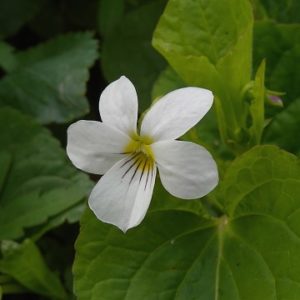 Viola canadensis, (vee-oh-lah, can-a-DEN-sis) is a tall white violet, being 8-16 inches tall. It grows in mounded clumps. The single white, 1” in diameter flowers, sometimes tinged with purple, hang face outward at the tips of short, slender purplish stalks which arise from the leaf axils. The petals are yellow at the bases. Blossoms are slightly irregular, with 5 white petals. This perennial likes rich, moist shady soil. Leaves are dark green and heart shaped. Violet flowers and leaves are edible. Candied blossoms are lovely decorations on the tops of frosted petit fours. The leaves are used for salads, as pot herbs and dried for teas. They are high in vitamins A and C. Be careful! The rhizomes, fruit and seeds are poisonous and should not be ingested.
Viola canadensis, (vee-oh-lah, can-a-DEN-sis) is a tall white violet, being 8-16 inches tall. It grows in mounded clumps. The single white, 1” in diameter flowers, sometimes tinged with purple, hang face outward at the tips of short, slender purplish stalks which arise from the leaf axils. The petals are yellow at the bases. Blossoms are slightly irregular, with 5 white petals. This perennial likes rich, moist shady soil. Leaves are dark green and heart shaped. Violet flowers and leaves are edible. Candied blossoms are lovely decorations on the tops of frosted petit fours. The leaves are used for salads, as pot herbs and dried for teas. They are high in vitamins A and C. Be careful! The rhizomes, fruit and seeds are poisonous and should not be ingested.
The dog violet, Viola adunca, (ad-UN-kah), Latin for hooked, is pale to deep violet in color. The lower three petals have purple veining, providing nectar guides, with white bases; the upper two petals have hooked spurs at the tips. Blossoms are 1 inch wide. They like streambanks and meadows. Round to oval leaves have wavy margins. Blossoms occur on 0.20-2.76 inch stalks. The stems branch from hairy rhizomes. Seed pods burst explosively to spread seeds far and wide. Viola adunca is the larval host for Myrtle’s silverspot butterfly (Spyeria zerene myrtlaea) in the Nymphalidae family, declared endangered in 1992.
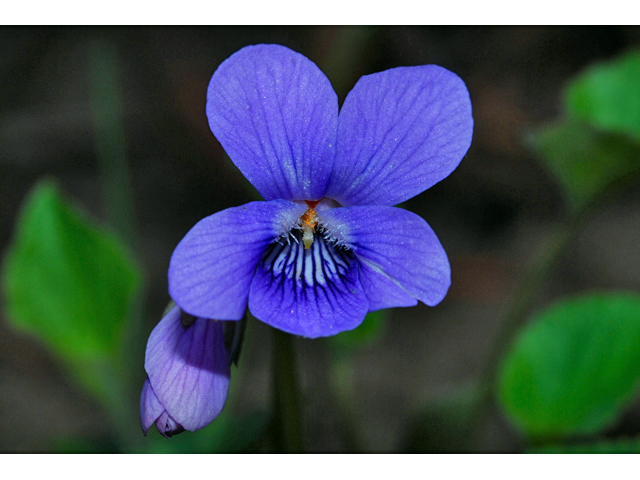
Early blue violet, Viola adunca. Courtesy Terry Glase, Lady Bird Johnson Wildflower Center.
Viola orbiculata (vee-oh-lah or-bic-u-lata): orbo means flat and rounded in Latin. It is yellow in color, with maroon nectar guide veins on its three lower petals. Like others in the Violaceae family, it has two petals up and three down. The blossoms, on reddish stems, are between 1-3 inches in diameter. Darkwoods violet plants occur in clusters without stolons. Basal leaves are round and scalloped. This native likes woods and subalpine meadows. Pollinators include bumblebee species in the Bombus genus. These are in the Apidae (bee) family, a good reason to protect endangered bumblebees.
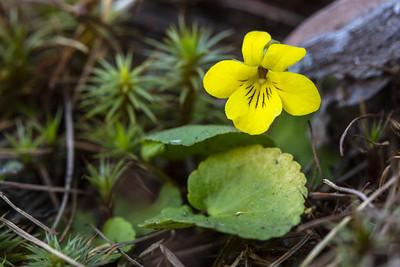
Darkwoods Violet – Viola orbiculata. National Park Service. Courtes Jacob W. Frank
We love the cultivated members of the viola family – pansies – for many reasons. They are beautiful, colorful and easy to grow, coming in white, yellow, blue and a purple so deep it is almost black. The plants are winter hardy in zones 4-8, surviving light freezes. I can plant my pots with pansies when I am tempted to “jump the gun” with vegetable plants. Woe is me for the loss of tomato plants to late frosts when I could not resist the lovely plants in garden centers!
Modern pansies were developed from wildflowers of Europe and West Asia often called heartsease. The blossoms are 2-3 inches in diameter with two upper panels, two side panels, a single bottom panel and slight beards at the flower center. All have an eye in the center. The name comes from the French, pensée, for thought. It is a symbol of remembrance- think of me- heartsease. In Italian they are called flammola, little flame. St. Euphrasia deemed it cheerfulness of mind, calling it, “The humble violet”. In Shakespeare’s Hamlet (Act , Scene 5) Ophelia said, “…there is pansies, that’s for thoughts”.
Pansies will grow to a height of 9 inches, and need to be deadheaded and kept from getting too leggy. They are not heat tolerant; they will not do well in intense summer heat. Do not over water. Once a week is enough along with feeding every other week. Problems: aphids, which spread cucumber mosaic virus; leaf spot; downy and powdery mildews; slugs and snails; and stem rot.
One might guess that a plant called, heartsease might have some unusual traditional uses. The juice of heartsease was said to be a love potion. As quoted from Shakespeare’s character, Oberon, in A Midsummers Night’s’ Dream (Act 2, Scene 1), “…on sleeping eyelids laid, will make a man or woman dote on the next live creature it sees.” Young American settlers liked to make pansy dolls. The blossom “faces” were glued to paper, leaves added for skirts with twigs to represent arms and legs. What more reason to indulge in plantings and pots of pansies this spring?
Thanks to Helen Woody and Janice Tucker for proofreading this article.
Sources:
Diffenbaugh, Vanessa. The Language of Flowers. Ballantine books Trade Paperbacks, New York, 2012. Print.
Harrison, Lorraine. Latin for Gardeners. The University of Chicago Press, 2012. Print.
“Images of Pansies-Viola-Viola tricolor-wildflowers of Europe and West Asia -Wikipedia”: Wikipedia. Web. Accessed 13 Feb 2021. Retrieved from:
Matteson, John. Eden’s Outcasts: The Story of Louisa May Alcott and her Father. W.W. Norton & Company, New York.London, 2008. Print.
“Pansy”. Wikipedia. Web. Web. Accessed 13 Feb 2021. Retrieved from https://en.wikipedia.org/wiki/Pansy.
“Roundleaf Violet – Violet orbiculata”. Montana Natural Heritage Program. Montana Field Guides. Web. Accessed 11 February 2021 Retrieved from: http://FieldGuide.mt.gov/speciesDetail.aspx?elcode=PDVIO041E0 .
SparkNotes editors. “No Fear Hamlet”. SparkNotes.com., SparkNotes LLC 2005, www.sparknotes.com/nofear/shakespeare/hamlet/
SparkNotes editors. “No Fear A Midsummer’s Night Dream”. SparkNotes.com., SparkNotes LLC 2005, https://www.sparknotes.com/nofear/shakespeare/msnd/page_42/.
Stearn, William T. Stearn’s Dictionary of Plant Names for Gardeners. Cassell Publishers Limited, London, 1992 Print.
“Viola adunca, (dog violet)”– Calscape.Web. Accessed 10 Feb 2021. Retrieved from: https://calscape.org/loc-California/Viola%20adunca%20(Dog%20Violet)?newsearch=1 .
“Viola adunca, (Early Blue Violet), Violaceae” Wildflowers of the Pacific Northwest. Turner Photographics. Web. 2021. Accessed 28 Feb 2021. Retrieved from: https://www.pnwflowers.com/flower/viola-adunca.
“Viola adunca”. Wikipedia. Web. 23 Jan 2021. 11 Feb 2021. Retrieved from: https://en.wikipedia.org/wiki/Viola_adunca.
“Viola canadensis, (Canada violet)”. Lady Bird Johnson Wildflower Center. Native Plants Database. Web. 22 Oct 2018. 11 Feb. 2021 Retrieved from: https://www.wildflower.org/plants/result.php?id_plant=VICA4.
“Viola canadensis, (Canadian White Violet)”. A Field Guide to the Flora of Minnesota. Minnesota Wildflowers. Web. 2021. 12 Feb 2021. Retrieved from: https://www.minnesotawildflowers.info/flower/canadian-white-violet.
“Viola canadensis”. Plant Finder. Missouri Botanical Garden. Web. Accessed Feb. 12, 2021. Retrieved from: http://www.missouribotanicalgarden.org/PlantFinder/PlantFinderDetails.aspx?taxonid=287518&isprofile=1&gen=Viola.
“Violets for Your Furs”. Wikipedia. Web. 31 Jan 2021. 26 Mar 2021. Retrieved from: en.wikipedia.org/wiki/Violets_for_Your_Furs.
“Violets for Your Furs/Genius Lyrics – Frank Sinatra”. Genius. Web. Accessed 26 Mar 2021. Retrieved from: https://genius.com/Frank-sinatra-violets-for-your-furs-lyrics.
“Viola orbiculata, (darkwoods violet)” USDA, NRCS. 2021. The PLANTS Database. http://plants.usda.gov , 11 Feb 2021). National Plant Data Team, Greensboro, NC 27401-4901 USA. 11 Feb 2021. Retrieved from: https://plants.sc.egov.usda.gov/core/profile?symbol=VIOR .
